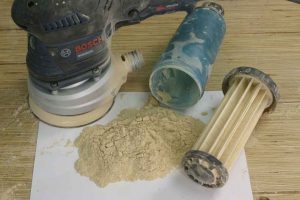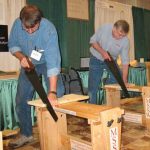We may receive a commission when you use our affiliate links. However, this does not impact our recommendations.
 During the past couple weeks I’ve taken a close look at a new Bosch sander while writing a review for our November 2011 issue. It’s a random-orbit sander with two really significant design changes that improve the user’s experience while sanding. Now you might think that’s an overstatement, but in my experience these two improvements actually are “game changers.” One is a “suspension” system that takes a big bite out of vibration – vibration has been a problem with these little machines since they were first introduced decades ago. The second big improvement is in the dust collection. This new rig uses an outsized canister that houses a pleated paper filter (you can also hook up the sander to a vacuum). Dust collection is significantly improved because the surface area of the filter medium is huge compared to other sanders.
During the past couple weeks I’ve taken a close look at a new Bosch sander while writing a review for our November 2011 issue. It’s a random-orbit sander with two really significant design changes that improve the user’s experience while sanding. Now you might think that’s an overstatement, but in my experience these two improvements actually are “game changers.” One is a “suspension” system that takes a big bite out of vibration – vibration has been a problem with these little machines since they were first introduced decades ago. The second big improvement is in the dust collection. This new rig uses an outsized canister that houses a pleated paper filter (you can also hook up the sander to a vacuum). Dust collection is significantly improved because the surface area of the filter medium is huge compared to other sanders.
But this got me thinking about these little machines we all take for granted. You think about a random-orbit sander, or most any sander for that matter, as, well, just a sander. But it’s also a dust collector in the same way a big dust collector hooks up to a jointer or planer. But whereas those hookups collect chips and shavings, your sander collects tiny dust particles – the kind that easily become airborne and are then inhaled into your sinuses and lungs. So you really need to pay attention to them. But do you?
If you are like most of us, you don’t empty – let alone clean – your random-orbit sander’s dust collection system nearly often enough. It’s usually a cloth bag hanging off the backside and “cleaning” means emptying the bag full of dust and no more. But when the bag gets overloaded with dust its ability to suck air through the sander and into the bag is severely compromised. Filters need airflow to work properly. When the filter medium becomes clogged air flow is restricted so dust isn’t sucked into the bag; it’s kicked up around the work being sanded and becomes airborne. Your actual sanding efforts are also diminished because the dust is left on the work to clogs the spaces between the abrasive particles limiting it’s ability to actually sand.
Also consider that the collection bag, when tilted in the direction of the dust port it’s connected to, is angled to dump a bunch of dust back into the sander. Turn the sander on and all that goes flying into your surroundings.
So empty and clean your random-orbit sander’s dust-collection system regularly during a sanding job. I’d recommend doing it every 15 minutes or so based on what I’ve recently observed. Not only empty the bag, but suck out dust that’s clogging the filter medium using a vacuum. And I do mean suck it out; don’t blow it out with compressed air. Blowing only drives, if not packs, the dust into the filter medium.
Keeping your filter bag clean not only prevents fine dust from becoming airborne and finding it’s way into your nasal passages and more, it also improves the productivity of your sanding. Get more done in less time. And when it comes to sanding, who’s not up for that!
If you’d like to know more about maintaining your power tools in good working order check out “David Thiel’s Power Tood Maintenance” book available in our store.
Here are some supplies and tools we find essential in our everyday work around the shop. We may receive a commission from sales referred by our links; however, we have carefully selected these products for their usefulness and quality.










I’m a firm believer in DC hookups to everything that makes dust, that includes have a downdraft sanding table for handsanding, etc. My shop DC does not have a bag or filter, but exhausts everything to the great outdoors. Which, besides keeping the dust out of the shop air, also increases the efficiency of the DC by quite a bit. I realize not everyone can just dump everything overboard, so to speak, but if you have the ability it’s well worth it.
I’ve known people who religiously hook up a DC or shop vac, wear a mask, etc. while working, and then don’t bother to wear a mask when emptying the bags or cleaning the filters! Wuwt?
Woodworkers are just about the only people that try to filter dusty air so they can re-use it (and re-breathe it!!!). Industry knows better.
Filters, whether small tool-based or large cartridges found on dust collectors, are a lose-lose proposition. As the article states and everyone knows, you must have airflow in order to collect the dust at the source. However, as soon as you start collecting dust the small holes or openings in the filter media start to clog. The more they clog, the worse the air flow becomes.
Without constant filter cleaning dust collection is mediocre at best. To make things worse, repeated cleaning easily damages the filter media so it will no longer filter out the fine (hazardous) particles.
The solution is to use a vacuum with bench tools or big dust collector with your machines to capture the dust, separate out as much dust as possible with a cyclone, then discharge the rest outside!
I don’t doubt that ROS dust collection is better these days than it used to be, but I “grew up” with sanders where the built-in dust collection was more or less worthless, so I’ve gotten into the habit of always hooking up a vacuum cleaner when using an ROS.
-Steve